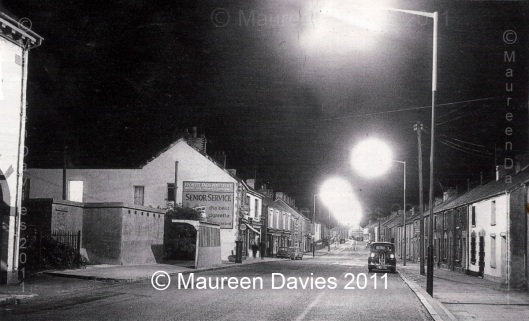Tags
Bass beer advertisement, Blackvale Works, Bovril, Bwrlais, Cae Bricks, cinema, Cwmbwrla, Cwmfelin, David Street and Robert Street, Gendros, Heol-y-Gors, Libanus, Manselton, Middle Road, Mission Hall, P.W Hussey, Star Supplies, Swansea, Swansea Works, The Three Sisters, Tivoli, Trainer, Welfare Halls, Wicks
The word “Cwmbwrla which means valley of Bwrlais”, Bwrlais Brook runs down along the right hand side of Heol-y-Gors, to the rear of Boots Opticians and Trainer BMW franchise. Cwmbwrla was known for its boundary of the Borough of Swansea for many years until the extension of 1918, when many other surrounding areas were also included within Swansea.
This photo is originally from a postcard taken in 1927. A smaller cropped area has been enlarged on this image which kindly came from Swansea Museum. The Tivoli cinema also known as Tivoli Hall was opened in (*1) 1913 at the junction of Carmarthen Road and Heol-y-Gors. In the (*1) orginal postcard photo, several chimneys are seen to the buildings left. They could be from Blackvale Works (copper) and Swansea Works (Tin), these factories were situated roughly between Trainer’s Mini car sales franchise and where Wicks DIY store are today.
The position of the cinema today, took me a while to be sure of after using a number of old books, photos and maps. The front of the building faced Libanus Chapel 1906. After a fire on 21st January 2012 the upper floor was demolished, along with roof damage of its earlier outgrown Old Libanus (1867) Welsh Baptist chapel next door. To the building’s left in the photo is Heol-y-Gors and left again would have been the Mission Hall today named Gorse Mission (F.1904) and built 1926. On the right of the Tivoli are a number of shops including the Cwmbwrla Post Office, then next door was (*2) P.W Hussey in 1910 and (*3) Star Supplies in 1965 on the end nearest the picture house. Running right in alignment with both, the nearest building oppersite and the cinema was Cae Bricks. This old road is now only a shadow of original size and can be seen from the rear of The Three Sisters pub, (a name taken from old Cwmfelin works where the tall chimneys were seen from miles around). The road carries on towards Manselton till it meets up with David Street and Robert Street.
In front next to the low capped wall, I’m puzzled by the metal looking shelter under the streetlight, if anybody who knows the answer could you let me know? The image looks like it’s been taken in the late afternoon judging from the shadows, near the three flat capped men and poster of the Bass beer advertisement. The tall street posts and their long arms holding the electric cables fed the tramway (*4) 1900-1937 (earlier, from 1874–1900 the tramways were horse-drawn), then came the faster and more efficient transport vehicle, the bus. The tramway, advertising “Bovril” (a salty meat extract drink, developed in the 1870s) on its roof, the tram has reached its terminus at Cwmbwrla and Middle Road can be seen climbing upwards towards Gendros. On the far right you can see a shop front with its canvas blind pulled down, this would give shade in the summer and would also help protect perishable goods. The cinema looks like it had a previous use, with the brick-up window on its left side, possibly a Welfare Hall built for community events and deteriorated, then began a new lease of life as a popular cinema. This happened with many other Welfare Halls around the area such as Fforestfach. If you know the building previous function, could you let me know? Latter on (*5) Morsmith Motors car showroom was sited here.
The building was demolished in 1960s, the area can be seen in a photo book by the (*6) Evening Post 1967, in preparation for the new dual carriageway and roundabout. The building is mentioned in OS maps from 1899 as “hall” and even 1972-95 a building is still shown in the same spot, I didn’t rely on latter maps after 1966 as they no longer label the building!
Source
(*1) Swansea in old picture postcards, J.R. Alban City Archivist, Swansea I100 1985 ISBN 9028890928
(*2) South Wales Evening Post Swansea Memory Lane p159 1999 ISBN 1859831737
(*3) South Wales Evening Post Swansea Memory Lane p74 1999 ISBN 1859831737
(*4) Swansea in old picture postcards, J.R. Alban City Archivist, Swansea I52 1985 ISBN 9028890928
(*5) The Story of Swansea’s Districts and Villages V2, C1, p46 Norman Lewis Thomas (volume 1 – abridged volume 2) 1969 ISBN 978-0-9501065-0-2
(*6) South Wales Evening Post Images of Swansea p57 1998 ISBN 1859831346
1879 OS MAP – shows Blackvale Works (copper) and Swansea Works (Tin), just a little higher than Babell Chapel (Welsh Calvinistic Methodist).
1936-38 OS map – shows works to the rear which are no longer named.





You must be logged in to post a comment.